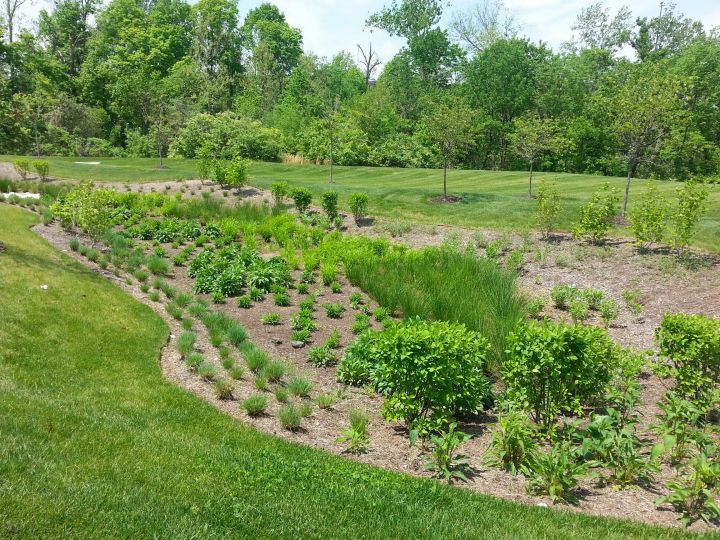As development across our region increases, so do the requirements for stormwater management solutions. That’s because the increase in the number of impervious surfaces is making it difficult for the environment to naturally deal with rainwater—and that’s causing problems when it comes to runoff.
With these concerns mounting, there has been a push to develop innovative solutions to the region’s stormwater runoff problem. Among those solutions, rain gardens make a great choice for commercial properties due to their attractiveness as well as their functional success.
What is a Rain Garden?
 A rain garden is a collection of native shrubs, perennials, and flowers which are installed in a depressed area of the landscape. This helps collect, hold, and “soak in” rainwater runoff from roofs, walkways, parking lots, and lawns.
A rain garden is a collection of native shrubs, perennials, and flowers which are installed in a depressed area of the landscape. This helps collect, hold, and “soak in” rainwater runoff from roofs, walkways, parking lots, and lawns.
Rain gardens have a wealth of benefits. They are able to help to filter stormwater runoff before it enters local waterways, alleviate flooding and drainage problems, and provide a habitat and food for local wildlife—all while adding aesthetic appeal to your property. According to the Groundwater Foundation, it has been estimated that rain gardens are successful in removing up to 90 percent of nutrients and chemicals and up to 80 percent of sediments from the runoff.
Should You Add a Rain Garden?
Now that you understand what a rain garden is all about, you might be wondering if you need one. The truth is, even if you haven’t been mandated to add stormwater solutions to your property, you’ll be ahead of the curve by doing so. It’s believed that increasing regulations are coming down the pipeline.
But regulations aside, the fact is, your property can benefit from a rain garden by eliminating the hassles associated with stormwater runoff. Rain gardens help prevent flooding and allow you to direct water where you want it to go—while also adding a lush, attractive look to your space. You’ll also feel good knowing that your property is no longer a pollutant source to local waterways. That’s a feel-good takeaway that your tenants or your clients will appreciate as well.
How to Maintain a Rain Garden
 Like any landscaped area, a rain garden does require some ongoing maintenance. While the use of native plants helps keep the maintenance tasks limited (after the first year, the plants shouldn’t require ongoing watering), your rain garden will still require occasional pruning and weeding to maintain its appearance and ongoing monitoring in order to ensure it’s continuing to function as it’s meant to. If any areas have been eroded over time, replacing plant material may be necessary. Rain gardens also require periodically refreshed mulch to help keep out weeds and retain moisture.
Like any landscaped area, a rain garden does require some ongoing maintenance. While the use of native plants helps keep the maintenance tasks limited (after the first year, the plants shouldn’t require ongoing watering), your rain garden will still require occasional pruning and weeding to maintain its appearance and ongoing monitoring in order to ensure it’s continuing to function as it’s meant to. If any areas have been eroded over time, replacing plant material may be necessary. Rain gardens also require periodically refreshed mulch to help keep out weeds and retain moisture.
Of course, you have a business to run and the last thing you want to do is worry about is maintaining a rain garden. Leaving those tasks to a professional will be one less thing on your plate. However, it’s important to note that not all landscape companies are familiar with maintaining a rain garden. It can require special training and skill. We have heard horror stories about landscape crews ripping out the native plants that made up a rain garden because they assumed they were weeds. You want a landscape company with crews that are trained to identify the difference between a native plant and a weed and who will know how to evaluate your rain garden to ensure it continues to function properly.
Install and Maintain a Rain Garden with Bluegrass
At Bluegrass, we have been installing and maintaining rain gardens long before they became a trend. We not only know the proper installation techniques to ensure they function well, but we have crews trained in their maintenance. By allowing Bluegrass to take care of your rain garden needs you’ll feel confident about making a smart decision for your property that will benefit you for years to come.




